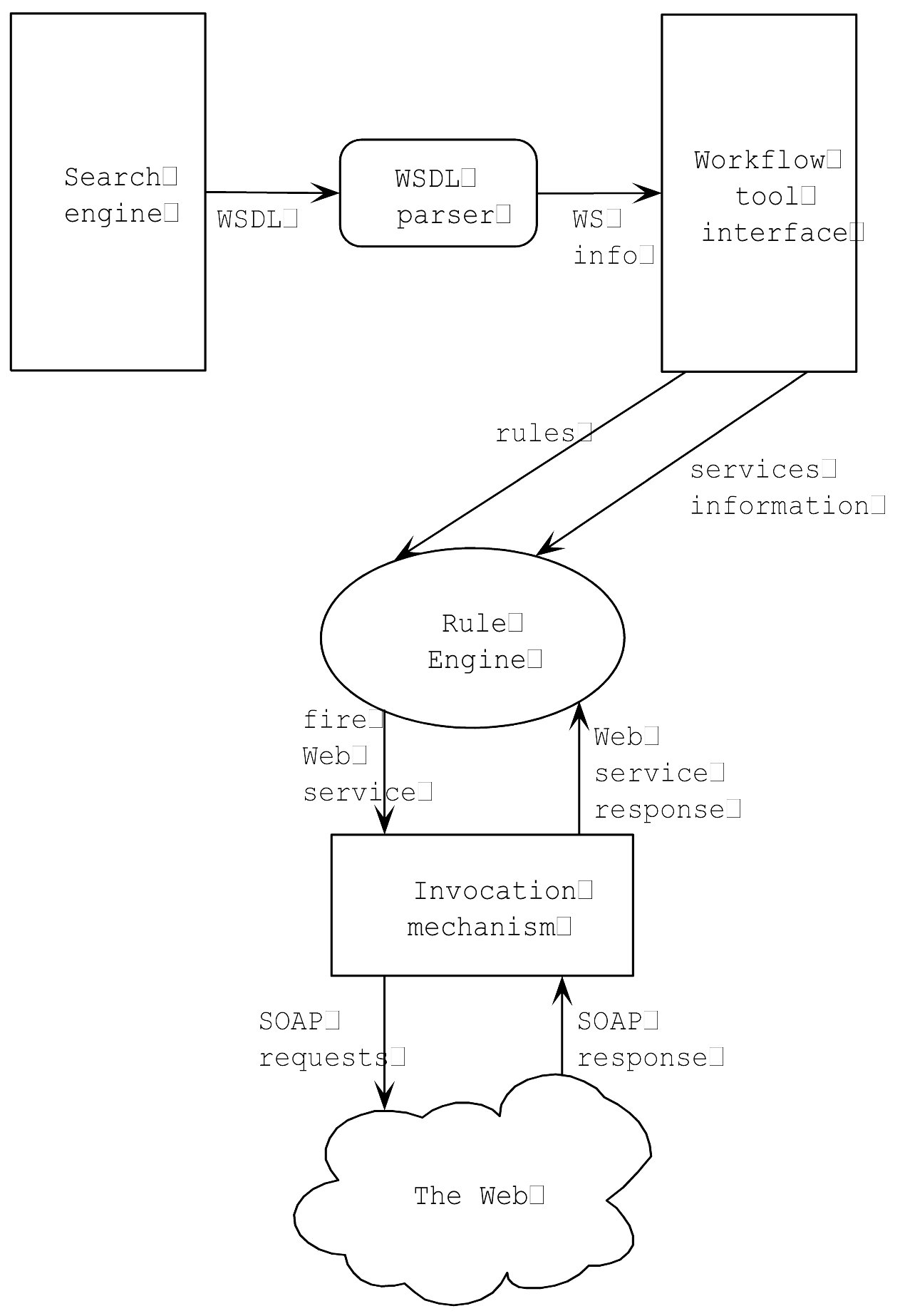Web Services Collaboration Workflow System
M.Montebello
CSAI departement,
University of Malta
Malta
+356 3290 2132
mmont@cs.um.edu.mt
D.Attard
CSAI departement,
University of Malta
Malta
ABSTRACT
In this poster we present the design and implementation of a tool that
enables users to define and invoke a Web Services workflow system. The
tool allows users to search for Web Services needed and then combine the
chosen Web services using a number of invocation rules and patterns.
The tool empowers the user to define a specific workflow and ensure that
the exact desired output from the combination of a number of Web Services
has been achieved.
Keywords
Web Services, Workflow, eCommerce, Semantic Web.
1. INTRODUCTION
The concept of conducting business through the medium of the Internet is
not a new concept. The first phase of eCommerce mainly dealt with
businesses offering a Web-enabled front-end to their products and services.
The next phase of eCommerce addressed the issue of business-to-business
transactions and relationships [1]. Web Services (WS) can be the
main enablers of this eCommerce phase. WS will allow back-end interactions
between computer systems, business applications and software components.
The WS architecture relies on a number of protocols, namely, SOAP (Simple
Object Access Protocol) [2], WSDL (WS Definition Language) [3], and UDDI
(Universal Description Discovery Integration)[4]. Using these protocols
a number of toolkits have been introduced by a large number of companies
who offer support in all new versions of applications that allow users
to expose their code as WS.
There exist several tools that allow simplified invocation of WS, however,
the real value of WS lies in combining several services, thereby getting
value from their amalgamation [5]. The combination of services in
a determined workflow is made easier through a tool we designed and developed.
2. WS Workflow Tool
The WS workflow tool allows the user to combine several WS to provide added
value to businesses using the WS architecture. The tool uses all
the protocols mentioned above. UDDI is used to discover services.
WSDL is used to determine the technical interfacing of the WS chosen, and
SOAP is employed when invoking the services. The tool we designed
and implemented to define the workflow is made up of two components, which
together offer the described functionality, namely, a WS Service Search
Engine, and a Workflow Definition and Invocation Tool.

3. WS Search Engine
This allows a user to specify a few keywords that describe a service. The
search engine then performs a search on available WS and returns the information
(in the form of a WSDL document) to the user. In order to download
the WS information, the tool needs to be able to connect to a UDDI registry
specified by the user [6]. After downloading the appropriate data
structures from the UDDI registry, the information required is extracted.
This includes the description of the WS (provided when the service is registered)
and the WSDL document of the service. If the WSDL document does not exist,
the tool checks if sufficient information exists to be able to obtain the
document, if this is not possible, the WS is ignored. When the correct
information exists, the WSDL document is extracted and its description
stored in an appropriate data structure to enable quick searching through
its description. The tool browses through the UDDI registry until
all the WS have been downloaded. Periodic runs ensure that the local
information is updated. As regards the search algorithms involved,
the user will supply keywords that are probably included in the description
of the WS required. Therefore, we implemented a search algorithm with multiple
criteria to go through the local information and find the best matches.
These include searching for ALL keywords, ANY keyword, exact phrase, case
sensitive search etc. Once the correct matches are found, they are
returned to the user, or stored in an appropriate data structure to be
used later on.

4. Workflow Definition and Invocation Tool
This tool allows the user to include results returned from the search engine,
and, with the help of a number of rules, designs the invocation pattern
of the services chosen. The workflow designed can then be executed.
The user is able to edit the workflow until the desired configuration is
achieved, but initial parsing of the WSDL document has to be performed.
Since the WS found by the search engine will be invoked, the necessary
information is extracted from the document, namely, input and output details
from the WS, its’ access point, and SOAP encoding types. The WSDL
document plays an important role as all necessary information is extracted
from it. The WS workflow rules of execution (sequential, parallel,
if-then, And, Or, etc.) handle the invocation pattern. A purposely-constructed
rule engine is employed to define a number of rules and the way that they
fire. The chosen services have their invocation stubs automatically
constructed to enable the successful SOAP communication when triggering
the flow of events. This will then be coupled with the rule engine
so that each client stub is executed at the appropriate time.
CONCLUSION
The workflow design interface complements the above-mentioned tasks as
it includes both the search engine and the design tool. The search yields
a number of WS that are dragged onto a design panel. A variety of
components allow the user to specify the rules of invocation thereby designing
the workflow - invocation follows. The outcome will be then be conveyed
to the user to confirm or edit the configuration of the workflow.
4. REFERENCES
-
Stef Joosten et.al. ”An empirical study about the practice of workflow
management”, WA-12 report, 1994.
-
Simple Object Access Protocel, http://www.w3c.org/TR/SOAP
-
Web Services Definition Language, http://www.w3.org/TR/wsdl
-
Universal Description Discovery Integration, http://www.uddi.org/
-
Dan Gisol "Web services architect, Part 1: An introduction to dynamic e-business,
http://www-106.ibm.com/developerworks/library/ws-arc1/
, April 2001.
-
Zoran Zaev et al. "Professional XML Web services", Wroxx Press Ltd, 2001.


